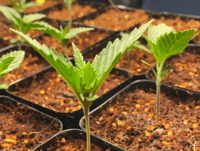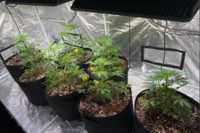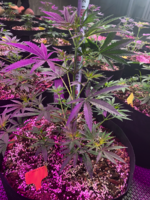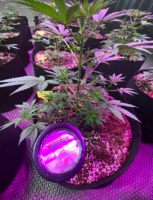The Proper Way to Water a Potted Plant
Also covered: the importance of pH and why we successively up-pot
How to Water
Over the last several years I have put a lot of study into this, and I feel that I can now define the proper way to water a potted plant. Keep in mind that this discussion applies to at least 3 gallon containers and bigger. Please realize that this special plant of ours does not grow like anything else you have ever tried to grow, and no matter how good you are at growing peas, beans and tomatoes, you will have to change your methods to grow a weed.
The first rule of watering is to always water slowly, using no more than a quart at a time, pausing often to let the soil suck air in behind the water as it pools on the top. For me, that involves a routine of watering each of my plants with 1 quart, then taking a nice relaxing drink of whatever beverage I have brought with me to the tent. Then I take a deep breath, making sure to exhale deeply onto this plant, letting her know that I love her. After this, I take a nice big hit off of the pipe that also followed me into the tent, and then after a nice pause and maybe another drink, I go back to plant #1 and repeat the cycle. For 2 rounds, I water the entire surface of the soil, watching it pool up and get sucked down.
After this initial wetting of the top, my watering method changes a bit. Now, I want to do whatever I can to make the outside edges of the container, the wettest areas. Still only using a quart at a time, I now carefully water only there, all around the plant, only on the edges. While doing this, I slow down a bit so that the water doesn't pool as much in the center, always concentrating on the edges. The center will end up getting some too, and that's fine, but the wettest areas of the pot will be on the outside edges and you will be driving nutrient rich soil into the dense original root ball. Continue this, again going slow, maybe with a deep breath in the middle of it, and then continue all around, taking drinks, deep breaths and hits in between each round. Continue until you see the first signs of runoff, and then stop.
Look carefully at the surface of your container now. You will clearly see where the root ball is from your last transplant, because it will now be sticking up just a little bit above the original outer rim. Very fine soil has been driven through the original root ball with the flow of water and soil from the outer edges. This micro fine soil is very rich with nutrients because of its mobility. When you water from the outside edges, you force this micro fine sludge into the dense root ball, where it can do the most good. Once you establish this flow pattern in the container, you can be assured of totally replacing the micro soil in the center of the root ball with new soil, every time you water. Watering in the normal way does not create his circular flow, and root growth cannot be nearly as aggressive.

Lastly, take one last quart of water, and water very very slowly, just in the raised area where the original root ball is. As you do so, watch what happens at the outer edge of the original root ball.
You will see the very finest soil, almost a mud, migrating out of the old root ball, and into the middle! This completes the process of soil exchange in the container. In this manner, all the roots get to take advantage of the nutrients in the soil, and the roots follow the migration of the nutrient rich soil, toward the outer edges, creating lateral growth. I strive to actively drive the soil out of the middle, making room for the roots to grow more dense and bigger there, and as they do, the lateral growth also has to increase. Using this method, I have seen a steady increase in the amount of water needed to get to run off throughout the grow and by the end, plants watered in this way use approximately 30% more water than is seen using standard watering techniques. Watering in the manner I have described allows for a constant circular flow of soil throughout the container and will create an extremely dense root ball.
Now it is time for a truism.
It is best to water the roots, not the plant. A healthy and robust root system means a happy and productive plant. Neglect the roots and your plants can die, and certainly will be less than they could have been.
When do we water?
By far, one of the most common plant problems that I see with new gardeners is a lack of understanding as to when to water. New people get it set in their mind that watering every day or every other day is best, or that somehow, mysteriously, they know in their own human minds exactly how much water the plants need. These well-meaning new gardeners will determine that they will give exactly one quart or some other random amount, each time, no more... and no less, and really believe that they are doing a good thing for their plants, making these decisions for them.
Just as bad as these over-thinkers are the tomato gardeners, the "stick your finger in the ground" crowd, who proclaim: it's time to water when it is dry below the second knuckle. What they fail to realize is that when the top 2 inches is dry, the lower half of the container could still be saturated with water. Both of these common mistakes in watering methods are quick ways to drown your plants. These methods are not correct for growing weeds, and using them can actually kill your plants.
Marijuana is a weed, and the main thing that this scientific term refers to, is a class of plant that thrives in adversity. In order to grow it well, you need to understand that this incredibly robust plant works differently than other, less hardy plants. It is an extremely aggressive grower if you allow it to be, and to grow prize winning pot, you need to use its abilities to send out new roots to your advantage.
Watering incorrectly is the most common mistake that new weed farmers make. This plant needs a clear wet/dry cycle in order to thrive. If you keep it moist, you will kill it. The roots will aggressively chase your water, whatever you give them. If you just give a small amount every couple of days, that water will drop right to the bottom of the container. Your roots will follow, and will cluster on the bottom, instead of growing laterally throughout the container, and since they continually sit in the nutrient rich water, the plant sees little need to grow additional roots. How you water makes a huge difference in the formation of the root ball, and how this development happens is up to you.
There are many ways to tell when it is time to water, and if you wait long enough the girls will actually tell you that they are thirsty. They do two things when they see that they need water, they throw out a smell, and they begin to wilt, starting at the bottom, moving up. You can also use the lift method to tell when the container is dry, and almost always you will "feel" a dry container, before the above mentioned wilt and fragrance pump happens. Rusty Trichome taught me an important lesson; every time I think that I need to do something to my plants, I wait a bit... and I try to move at the speed that my plants are moving.
"Patience, above all else." --Rusty
If you have a moisture meter you can also use it to find where the wet/dry (water table) line is in your container, and you can watch that wet/dry line move down over time. I used to graph my water table level by day, so that I could project ahead when the wet dry line would reach the last inch of container. Your wet/dry line will never go lower than that last inch or so, because once you get down in there, you are in all the big tap roots and mass at the bottom, and it tends to stay wet there longer because of capillary effect. Again, if you wait for the first sign of wilt and that perfume pump that happens at "water me" point, it will usually be just a bit longer than your measurements would indicate. Once the water table line is anywhere in that bottom inch is ok to water. You have dried out 95% of the water by that time and the roots have been chasing it as the wet/dry line progresses both downward and outward. The suction caused by the diaphragm that is the water table, will have pulled oxygen down deep into the container, and filled any voids. The roots will be happy.
Why do we up-pot?
The art of successive up-potting is important in growing a healthy root system. People like to be lazy. I am constantly seeing new gardeners take a little sprig of a weed and put it in a big 3 or 5 gallon container, thinking that they have done a good thing, and are now done with it... it's on to harvest time! The problem is, this doesn't work, because it gives you zero control over developing the roots, and without crazy watering techniques, almost no chance of a solid root ball forming. It is imperative to successively up pot your plants through stages so that the root system can roughly take on the same size and shape as the plant in order to get the maximum productivity. The roots grow aggressively in these weeds, and if you confine them to a container the size of the plant, they will fill that space in a short time with a dense root system. Putting a plant in an oversized container can and often does, result in all the roots going to the bottom, drowning the plant, root rot and overall poor health because of a lack of a root ball, and certainly less than optimum harvests. It is important to force these weeds into producing a root ball at various stages, to give the plant the ability later on to take in the massive amounts of nutrients needed to produce lots of quality buds.
The plants in the smaller containers can also more directly show you when they are thriving or more importantly when they are not. A strong healthy plant will eventually outgrow its container and an observant gardener is carefully watching the length of time between wet/dry cycles, and directly relating shorter cycles with more robust roots. A smaller container also gives the gardener the ability to see when the moment arrives that the amount of soil the plant is in is no longer large enough for the plant's abilities to be happy in it, because it will be obvious when the plant can drain the water that soil is able to hold, in less than 24 hours. Your soil and your container at that point have ceased at that point to be a good enough buffer, and it is time to double the space the roots have to work with. Let your plant show you when that time is, and try not to make decisions for her.
Why is pH important?
Some people claim that pH is not important, and if you are a pure organic gardener, never applying chlorinated water or salt based synthetic nutrients at your plants, pH indeed is
not important. For the 99.9% rest of the world, a very important lesson for the new gardener to learn is the importance of pH. There is a scientific reason why a proper pH allows the plants to use synthetic nutrients, and why being outside of the proper range can cause deficiencies. If you want to grow pot using chemicals, you need to invest in a method to test the pH of any water going into the plant, whether it is plain water or water mixed with nutrients, and whether it is applied to the roots or sprayed on the leaves. If you neglect the pH, you can easily create deficiencies in your plants, and if left unchecked, you can even kill them. If you spend a lot of money on nutrients, it makes sense that you would want to also create the proper environment so that the plant can use these nutrients, but with a pH way out of the 6.3-6.8 range in soil, a lot of those expensive nutrients will just sit there, not doing the plant any good. If you are in a soilless mix, pH in the range of 5.5-6.1 is necessary. It is only within these ranges that all the nutrients are mobile, are able to be broken free of their salt bonds and be in the form that can go into the plants. Most soils and systems are designed so that you can apply liquids at a lower pH and then the soil or the soilless mix causes a drift, so that the pH can visit each spot in the usable pH range for that medium, and all of the 17 needed nutrients will be picked up, each in its turn.
I hope that this study on containers, watering and pH helps someone who reads it. This paper was a result of having to explain these same concepts over and over and over again to new growers at they hit the forums, until finally I put all these thoughts together into this paper. Some of the thoughts previously given have also been refined for this publication, as questions were asked and answered the last time I posted it, and I have learned better ways of explaining my thoughts. Here, I give you, approximately draft 10 of this paper.
Be well everyone and blessings from my garden to yours,
Sense Emilya










